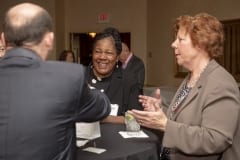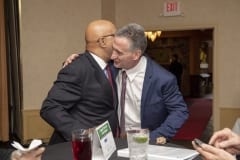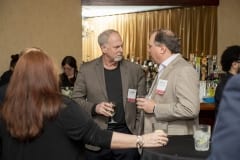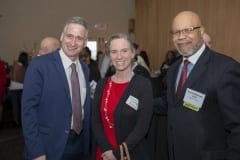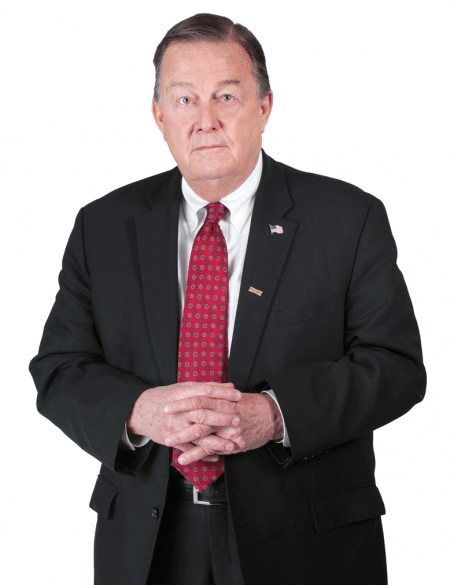Organizers of Springfield’s C3 Policing Program
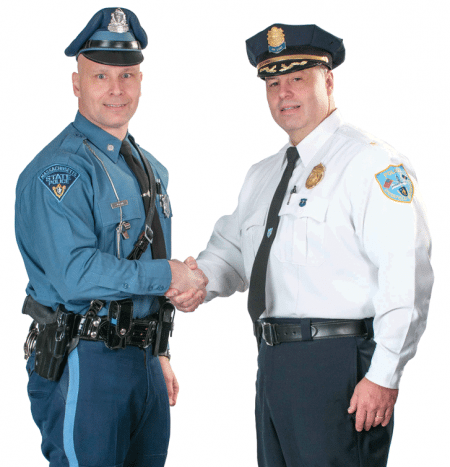
Michael Cutone, left, and John Barbieri. (Note: Tom Sarrouf was on assignment with his SF units and not available to be photographed.)
Michael Cutone was asked how he could tell if the C3P, or Counter Criminal Continuum Policing program, in Springfield’s North End was succeeding with its various goals in the manner that organizers anticipated when they commenced the initiative roughly three years ago.
The Massachusetts State trooper and master sergeant in the U.S. Army Special Forces (the Green Berets) paused for a second and nodded his head a few times, as if to indicate that he gets that question often, and that he had an answer.
Actually, he had several.
For starters, he told BusinessWest, there is statistical evidence showing often-dramatic reductions in what would be considered gang-related crime in the Brightwood neighborhood since this program, based on tactics used by the Special Forces in Iraq and Afghanistan, went into effect. Comparing 2010 statistics with those from 2009, before the initiative started, there was a 76% decrease in larceny, a 66% drop in weapons violations, a 55% reduction in burglary, and a 47% decline in motor-vehicle thefts.
But there is also anecdotal evidence concerning what is being called a counterinsurgency, or COIN, program, he said, listing everything from reports of gang members throwing their cell phones into the nearby Connecticut River because they believe the police must have them bugged — so accurate is their information about gang activities past and planned — to other reports of gang operatives offering to pay neighborhood residents for information on what those leading the C3P operation are up to.
Meanwhile, there’s the rising number of communities and police departments looking to emulate this model — officials have come from as far away as the Netherlands to observe the concept and talk with its organizers — and the growing volume of press it’s generating; the New York Times and Boston Globe have done stories, and 60 Minutes will present a report on the program later this winter.
Still, with all that, Cutone prefers to sum things up with what he calls the “non-traditional answer,” a summation of what residents and neighborhood activists are saying about C3P at what amounts to the heart of the program, regular Thursday community meetings designed to share information and ideas and continuously strengthen the relationship between the police and area residents. Or what they aren’t saying, as the case may be.
“No one’s saying, ‘you guys suck, and we don’t want you here anymore — this is a all a bunch a crap,’” he explained with a laugh, noting that such sentiments work as effectively (for him, anyway) as the crime stats, media attention, and cell phones in the river.
Collectively, they tell him that the COIN operation is meeting its overriding goal — to make things very uncomfortable for the gangs that once ruled these streets through intimidation, so much so that they’ll want to get out of the various businesses they’re in, especially selling drugs. And this happened because the program has succeeded in getting residents involved in making their streets safer, where once they were “inured, apathetic, and afraid.”
Those are three words that John Barbieri, deputy chief of police in Springfield, used early and often as he talked with BusinessWest about C3P. He is the official within the department with whom Cutone and Tom Sarrouf, a fellow state trooper and team commander of Cutone’s Special Forces (SF) unit, worked most closely to get this program implemented.
“The problem with the communities we’re talking about is that there’s very little involvement with the police,” he said, adding that the gangs in the North End had thrived in part due to what amounted to passive support from the community. “And there are myriad reasons for this, but a lot of this boils down to them not being stakeholders — these people are, for the most part, very poor, and they’d become inured to gang violence, violence in general, and drug dealing.”
In very simple terms, the C3P program has succeeded in making people claim a stake, he went on, and by doing so, they are considerably weakening that base of passive support.
Sarrouf agreed. “The residents there are now engaged in their community, where before they were not, plain and simple,” he said, referring to the most tangible and far-reaching benefit derived from what has become known in SF circles as the “Avghani Model,” named after the small town in Northern Iraq where these tactics were employed successfully to gain the trust and support of the local population and make them a resource in the fight against the enemy.
For their success to date and the promise of much more, Cutone, Barbieri, Sarrouf, and all those people in the community who work with them are truly Difference Makers.
Joining the Force
As he talked about how the COIN program works, Cutone offered a few analogies to help get his points across.
The first is what he calls the “seagulls and the Labrador retriever on the beach” scenario. Elaborating, he said that, while the dog will scare the birds away, they will merely hover or fly off, eventually to return; their lifestyle is interrupted, but not changed. The same is true, he said, with a typical police crackdown, or increased police presence, in an area like Springfield’s North End.
Another analogy involves a water balloon. When one pushes a finger into a full water balloon, it compresses that area, he said, noting that, when the finger is removed, the balloon returns to its original shape. What C3P is designed to do is apply several pressure points and not relieve that pressure, thus permanently altering the shape of balloon, or, in this case, a neighborhood. And a third analogy references a farmer battling weeds; unless one gets to the root of the problem and removes the weeds, they will keep coming back.
Using such effective visuals, Cutone, Sarrouf, and Barbieri explained how a COIN operation, and this one in particular, goes well beyond most traditional police tactics and the community-policing concept as a whole to involve a neighborhood in efforts to reduce crime.
And such extreme tactics are necessary, said Cutone, because gangs, like insurgents in foreign countries, are clever opponents not usually thwarted by what would be considered conventional approaches.
“Gang members and drug dealers are very savvy; they exploit the fact that people don’t want to engage with the police,” he explained. “They exploit that passive support. Just like insurgents, they move into areas where people are not going to report on them. Terrorist training camps don’t set up shop in Longmeadow or Belmont, Mass. They set up in Yemen, Afghanistan … failed states. Well, gang members and drug dealers will move into a failed neighborhood for the same reasons.”
‘Failed’ would be one effective way to describe Brightwood in the early fall of 2009, said Barbieri, adding that it was, at that time, the scene of heightened gang violence and activity, punctuated by several murders, including one “finished off” near the entrance to the trauma unit at nearby Baystate Medical Center.
In response to the surge, Springfield police countered with heightened patrols and a spate of arrests. “We were carrying assault rifles because they were carrying assault rifles,” he recalled, adding that, while police were diligent in their work, the results were basically similar to that of the retriever on the beach.
It was about this time that Cutone — who had attempted to initiate a counter-insurgency program in Brightwood based on tactics used by the SF, but seen it back-burnered — made another push. And the reason was obvious to those fighting crime in that neighborhood at that time, he said.
“It was clear that, just as we couldn’t kill our way out of insurgency in Iraq, we weren’t going to arrest our way out of this gang and drug problem,” he said.
Instead, the answer lay with intelligence, said Barbieri, returning to his thoughts about making residents stakeholders.
“It’s the community involvement that separates these neighborhoods from the suburbs and even the more affluent areas of Springfield, such as 16 Acres and Forest Park,” he explained when talking about the attitude that existed in Brightwood three years ago. “If there’s a crime in those neighborhoods, people become involved. If there’s drug dealing, they don’t tolerate it. When they call the police, they demand results — they go out and take pictures of the people involved; they take down license plates.
“In Brightwood, we were working like animals, but it all boils down to intelligence, and no one was telling us what was going on,” Barbieri continued. “No matter how long I work your neighborhood, no matter how much patrolling I do down there, I don’t know your neighborhood like you do — you know who’s dealing drugs and who’s hanging out in front of your house all day. It’s a community that keeps a community safe.
“Trooper Cutone comes up to me at a meeting and says, ‘I just got back from Iraq; there’s a counterinsurgency model to target gangs where we get the community involved and committed, and we try to change the conditions and build capacity in the neighborhoods,’” he went on. “I was the right target audience, and this was the right target location.”
For Your Information
Cutone recalls that the COIN initiative got its unofficial start with what he described as “dismounted patrols,” where he would get out of his cruiser and walk into shops and engage the owners and employees.
“That’s something we would do in Army SF when we were deployed in remote areas — we would live amongst the villagers and get to know them,” he explained. “Using that principle that I was taught, I would walk into a lot of these Hispanic shops, using my limited supply of Spanish to simply say ‘hello.’ These folks would look at me like a hog staring at a wristwatch, saying, ‘why is this trooper in my shop having coffee and asking me how I’m doing?’ So I got the cold shoulder in a lot of places.”
Changing attitudes and generating the steady flow of information, or intelligence, that the program needs to succeed took the better part of year, said those we spoke with, adding that the process of building trust and a working relationship with the neighborhood’s residents was difficult, and it is in many ways ongoing.
There are many moving parts within the program, but its heart and soul is the regular Thursday community meetings, staged at a few different locations, such as the apartment complex at 101 Lowell St.
At these sessions, updates are given, information is shared, and ideas are launched, such as the so-called ‘walking school bus’ concept — teachers chaperoning groups of students as they walk to school in the morning — which was offered by an employee of the Baystate Brightwood Health Center.
Overall, trust is built and momentum is generated through these meetings and other initiatives, such as regular Saturday neighborhood walk-throughs during which police officers will knock on doors and engage residents, other types of outreach efforts, classes on how to report crimes and spot gang activity, and ‘text-a-tip,’ which enables residents to forward information anonymously, said Cutone and Barbieri, adding that the results have been dramatic when it comes to the residents of the neighborhood taking that stake they once resisted and becoming an invaluable resource.
“We gave them our work numbers, our work cell numbers, our e-mail addresses, we gave them classes in how gangs recruit youths and how to identify if your child is in a gang — those types of things,” said Cutone. “And what happened, little by little, is that, between the Thursday meetings, the walk-throughs on Saturdays, and these classes, the amount of criminal information started increasing exponentially.”
And this volume represents a radical departure from what the police are accustomed to, and normally forced to subsist on.
“Typically, narcotics units and gang units get their information from criminal elements — I arrest a bad guy, he’s looking at X number of charges and X number of years, so all of a sudden, he wants to cooperate with the police, so he gives me another bad guy,” Cutone explained. “That’s a good technique, and we still use that technique; the problem with it, though, is that you’re minimizing your information flow, because 95% or more of the people in a community are law-abiding citizens. If you’re only dealing with the criminal element, you’ve eliminated 95% of your information flow.
“So now I have all this intelligence coming into my work computer — I’ve had guns and drugs located because informants would send material to my work cell phone and we’d be able to make arrests and recover stolen weapons,” he continued. “None of that would have happened if we hadn’t built this rapport with the local population.”
This steady flow of information has changed life for gang members to the extent that there are reports that some are buying new cell phones every month because they believe the police are somehow tapping the lines, said Barbieri, adding that there have been other reports of residents trying to chase away undercover police officers working the neighborhood, believing they’re there to buy drugs.
As for the neighborhood as a whole, there has been palpable change, said Sarrouf.
“When you ask people what’s different about living there now as opposed to before the program started, they’ll tell you very candidly that it’s safer, they feel more engaged in their own community, and they feel more empowered to be able to participate in the direction their community takes with respect to the issues that they had prior to this.
“Before, the North End was just truly chaotic; that’s the only way to describe it,” he went on. “Is there still crime there today? Of course, but it is at a much more manageable level, where there’s trust built between the community, city government, and law enforcement where they can respond more accurately, in a more timely fashion, and with a better approach.”
State Rep. Cheryl Coakley-Rivera, who represents that neighborhood, used different words to say essentially the same thing.
“There’s a renewed sense of hope — that’s the word I keep coming back to,” she explained. “But there’s also a sense of action and responsibility. If I’m a resident and I go to one opf these meetings, I come away thinking, ‘what can I do? — I have a team behind me now. What is my responsibility when it comes to working with that team?’ Is it just to fix my fence or clean up my yard, or is it call text-a-tip because I saw a guy put a gun in his trunk?’ There is a new sense of responsibility.”
To a Different Beat
Despite the gains in Brightwood, Sarrouf said, there is still much work to be done in this neighborhood.
“We’re not trying to fool anyone and present this as any kind of quick fix,” he explained. “Right up front, we said that this is a very long-term project, one that will take years to accomplish all its goals. Are we there yet? No, but we’re seeing incremental dividends with respect to the fact that the community is getting better over time.
“And what we’re not seeing is a fallback to what it was — which is a very good thing,” he continued.
In other words, there is more than sufficient evidence — both hard and anectodal — to suggest that this program is working, and that those who have put it in a position to succeed are worthy of being called Difference Makers.
George O’Brien can be reached at [email protected]
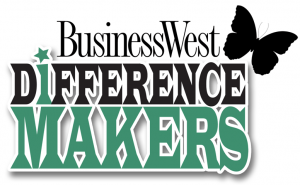 More than 350 people turned out at the Log Cabin Banquet & Meeting House in Holyoke for a celebration of BusinessWest’s Difference Makers for 2013. The photos on the next several pages capture the essence of a special night, which featured entertainment from the Children’s Chorus of Springfield and the Taylor Street Jazz Band, fine food, and memorable comments from this year’s winners, who all conveyed the passion that has made them true Difference Makers. This year’s class, chosen by the editor and publishers of the magazine from dozens of nominations, reflects the many ways in which individuals and groups can make a difference in the community. State Troopers Michael Cutone and Thomas Sarrouf, along with John Barbieri, deputy chief of the Springfield Police Department, were chosen for their work to orchestrate the C3 Policing program in Springfield’s North End. John Downing, president of Soldier On, was selected for the many ways that organization improves quality of life for veterans. Bruce Landon, president and general manager of Springfield Falcons, was chosen for his efforts to keep professional hockey in Springfield over the past 35 years. The Sisters of Providence were chosen for their 140 years of service to the community, especially in the broad realms of healthcare, education, and social service. And Jim Vinick, senior vice president of Investments for Moors & Cabot Inc., was chosen for his work with many area nonprofits, especially the Naismith Memorial Basketball Hall of Fame and the Jimmy Fund.
More than 350 people turned out at the Log Cabin Banquet & Meeting House in Holyoke for a celebration of BusinessWest’s Difference Makers for 2013. The photos on the next several pages capture the essence of a special night, which featured entertainment from the Children’s Chorus of Springfield and the Taylor Street Jazz Band, fine food, and memorable comments from this year’s winners, who all conveyed the passion that has made them true Difference Makers. This year’s class, chosen by the editor and publishers of the magazine from dozens of nominations, reflects the many ways in which individuals and groups can make a difference in the community. State Troopers Michael Cutone and Thomas Sarrouf, along with John Barbieri, deputy chief of the Springfield Police Department, were chosen for their work to orchestrate the C3 Policing program in Springfield’s North End. John Downing, president of Soldier On, was selected for the many ways that organization improves quality of life for veterans. Bruce Landon, president and general manager of Springfield Falcons, was chosen for his efforts to keep professional hockey in Springfield over the past 35 years. The Sisters of Providence were chosen for their 140 years of service to the community, especially in the broad realms of healthcare, education, and social service. And Jim Vinick, senior vice president of Investments for Moors & Cabot Inc., was chosen for his work with many area nonprofits, especially the Naismith Memorial Basketball Hall of Fame and the Jimmy Fund.













